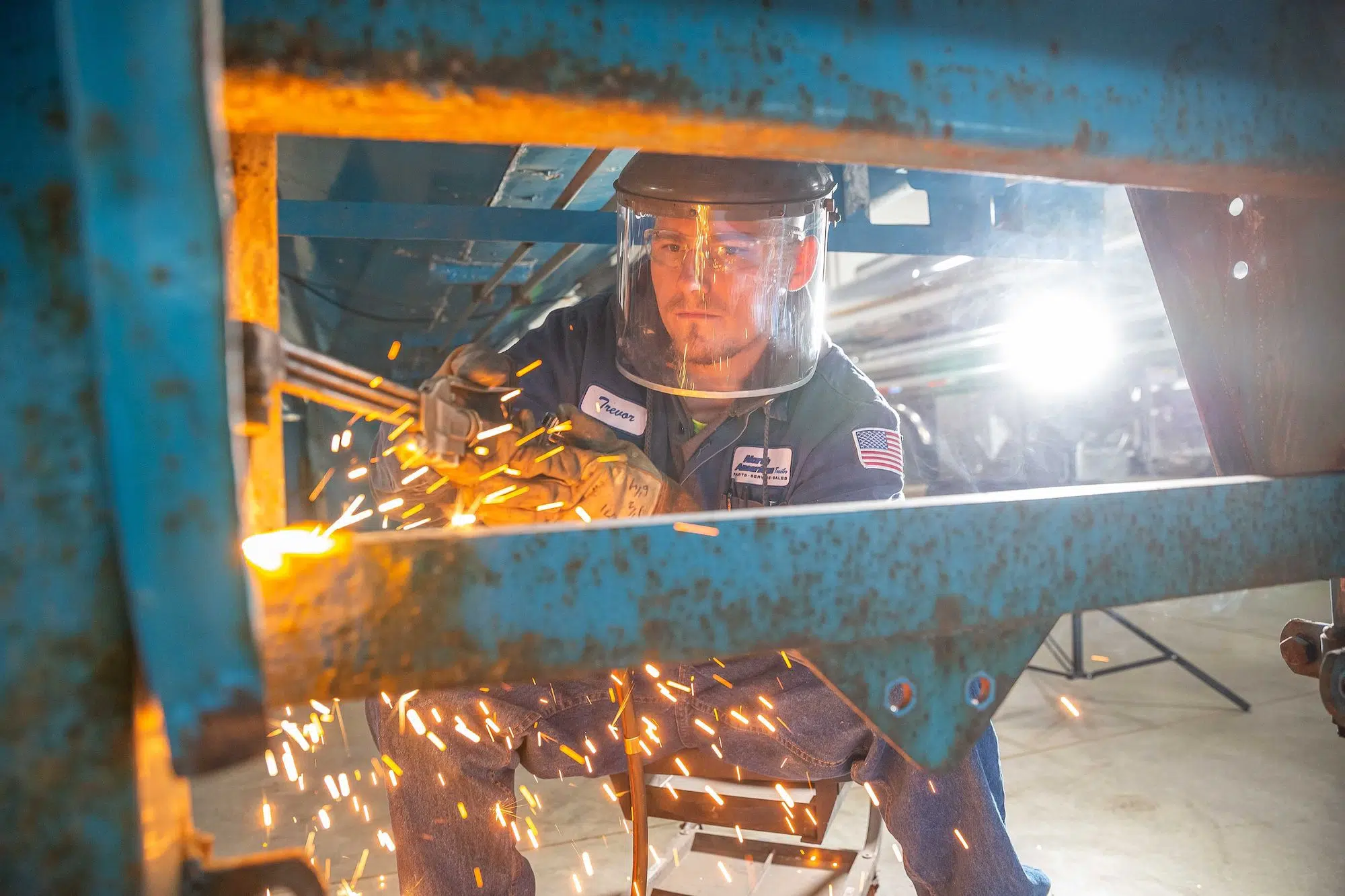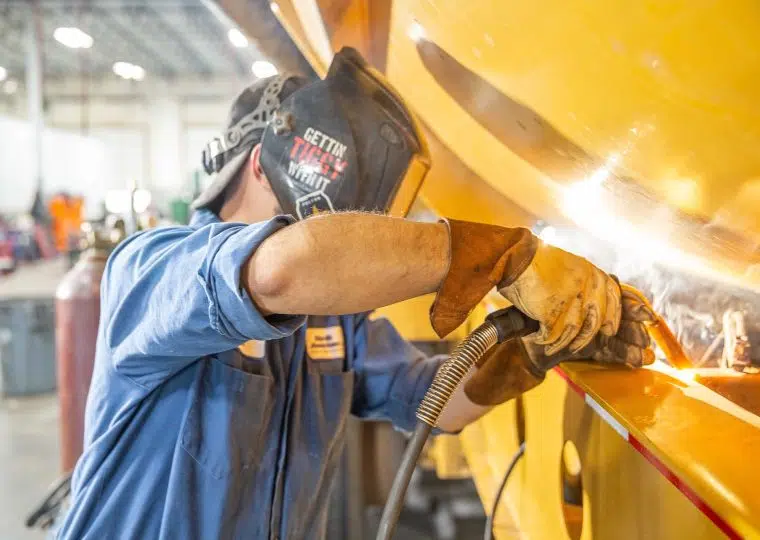Welding is incredibly important for the trucking industry at large. There are circumstances where owner-operators and fleet managers will need repairs done to a truck or trailer, and welding is often the best choice for a lasting repair.
Not only is it a much stronger fix that minimizes the chance of failure, but it can be done in situations where a fix isn’t possible in other ways. Welds are able to stand up to the rigors of the transport industry, but there are several different types of welding processes, and understanding when each should be used is vital to finding the right welder for the job.
What are the 4 main types of welding?
The four main types of welding are:
- Gas Tungsten Arc Welding (TIG)
- Gas Metal Arc Welding (MIG)
- Flux-Cored Welding (FCAW)
- Stick Welding or Shielded Metal Arc Welding (MMA/SMAW)
Of these four types of welding, MIG welding is most commonly used in the trucking industry. Compared to other types of welding, MIG can be performed more quickly and used on a wider range of metals while still producing quality welds. However, in certain scenarios, TIG, SMAW or FCAW may be preferred for truck repairs. Sometimes, plasma arc welding (PAW) may also be used for truck repairs. PAW is similar to TIG, the primary difference being that there is a separation between the plasma arc and the shielding gas.
Here is a bit more information about these types of welding.
TIG
What is TIG?
TIG is a gas-based arc welding process that uses an electrode made of tungsten. Tungsten is used in a wide range of industrial and manufacturing fields due to its incredible toughness and its ability to resist damage from dissolving or burning.
The gas supply used to facilitate TIG welding is generally either helium or argon. TIG welding is known for being able to fuse metals either with or without a filler metal, which gives it higher precision and strength than other welding types. TIG welding can be used on virtually any metal, making it highly versatile.
What’s TIG used for?
TIG welding is most commonly seen in auto manufacturing and the aerospace sector, as well as a wide range of other industrial applications. You will encounter TIG welds on everything from metal wagons to farming combines, and from semi-trucks to components for the international space station.
Benefits of TIG welding
TIG welding has the greatest variety of applications since it can be used with nearly any metal. TIG can be used to weld stainless, Chromoly, aluminum, nickel alloys, copper, brass, magnesium and gold. TIG welding is also known for creating some of the highest quality, cleanest-looking welds. TIG welding rigs are often controlled by a foot pedal, which means the welder has increased stability by using both hands if needed.
It’s also one of the cleanest ways to weld. The shielding gas means there is no slag or flux to get rid of between weld passes. Additionally, since the filler metal is only added in the exact amount needed, there are no spatters or sparks from excess material.
TIG welders also have less to worry about in terms of fumes or vaporized contaminants, unless already present in the metal being welded.
MIG
What is MIG?
MIG stands for “metal inert gas” and MIG welding has been popular in the US since the 1950s, initially being used for the relatively delicate welding of aluminum. It involves a bare electrode that creates a high-temperature arc to the metal being welded, but unlike some other methods, the arc is surrounded by a gas shield. Gasses used with MIG welding include inert gasses like argon.
What’s MIG used for?
Due to some of the limitations involved with the MIG welding process, it is often used for welding thinner materials that are located indoors. MIG welding is used on metals that tend to be a little harder to work with, such as aluminum.
Typically, you’ll find MIG welds used in garages and body shops, homesteads and farms, light-duty maintenance repairs, light fabrication and even weld-based artwork.
Benefits of MIG welding
MIG welding is much more efficient and productive with regard to the time spent welding than most other forms of welding, since there is no need to swap welding rods or clean slag and flux off of the resulting weld. The shield gas prevents contaminants from depositing on the weld pool.
MIG welding is also seen as much easier and quicker to learn than TIG welding while producing much better results than stick or fluxed-cored welding.
Fluxed Cored
What is fluxed cored welding?
Flux-cored arc welding, sometimes referred to as “FCAW” or “dual-shield welding,” is a method of welding that uses similar equipment to MIG welding. It consists of an electrode that is continuously fed a wire of filler metal and a supply of high voltage.
Flux-cored welding can feature a shielding gas or it can be done without and can result in higher productivity than welding with active gasses. The main protection of the weld pool during fluxed-cored welding is from the melted flux, which results in a slag deposit.
What is fluxed cored welding used for?
Flux-cored welding was initially developed for welding heavy, structural steel components. It is generally used with carbon steel and cast iron, as well as with stainless steel and many different alloys. However, it cannot be used for some nonferrous metals, such as aluminum.
Benefits of fluxed cored welding
Flux-cored welding is much better at joining thicker materials than MIG welding. It’s also better in situations where the welder needs to work outside since they will not have to worry about losing their shield gas to the wind, as the filler wire is able to provide all the shielding needed. It is a faster welding method than MIG and can be used in a wider variety of positions that may be needed for inconvenient or difficult repairs.
MMA/SMAW
What is stick welding?
Shielded Metal Arc Welding (SMAW) is also known simply as “stick welding,” due to the use of consumable rods or “sticks” of filler metal with built-in shielding. The stick functions as both the electrode and the filler metal and facilitates the arc between the stick and the metal being welded. As the arc heats the stick, it melts and deposits the protective shield material, and the filler metal melts, creating a slagged weld.
What is stick welding used for?
Stick welding has an incredibly wide range of applications, from general repair and facilities maintenance to industrial fabrication. It is also one of the only welding processes that can be used underwater, making it the ideal choice for underwater pipeline repairs and maintenance. Stick welding is an acceptable solution for welding nickel, copper, aluminum, and steel or iron.
Benefits of stick welding
One of the biggest benefits to stick welding is its portability. There are no gas cylinders needed, no expensive wire feeders and only the most basic level of equipment is needed. As long as there is sufficient voltage and something insulated to clamp the rod in, stick welding is a possibility.
Since there is no shielding gas needed, it can be used in nearly any dry conditions, both indoors or outdoors. Like MIG welding, it’s considered one of the easiest welding processes to learn.
Trust In Welding Professionals For All Your Truck Repairs
Welding is a skill that takes years of experience and practice to become proficient in. While there are a lot of truck repairs that you can handle yourself, welding is generally best left to the professionals.
If you notice damage to your truck or trailer, the best metal-to-metal repair solution will often be welding, so make sure you trust your rig to experienced, local professionals. Bring your truck in and talk to the coded welders at NAT today!


